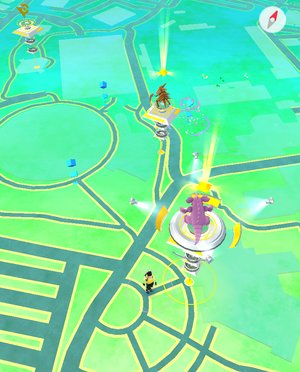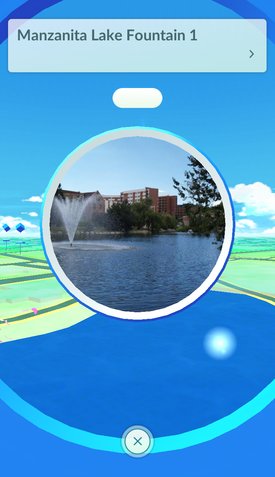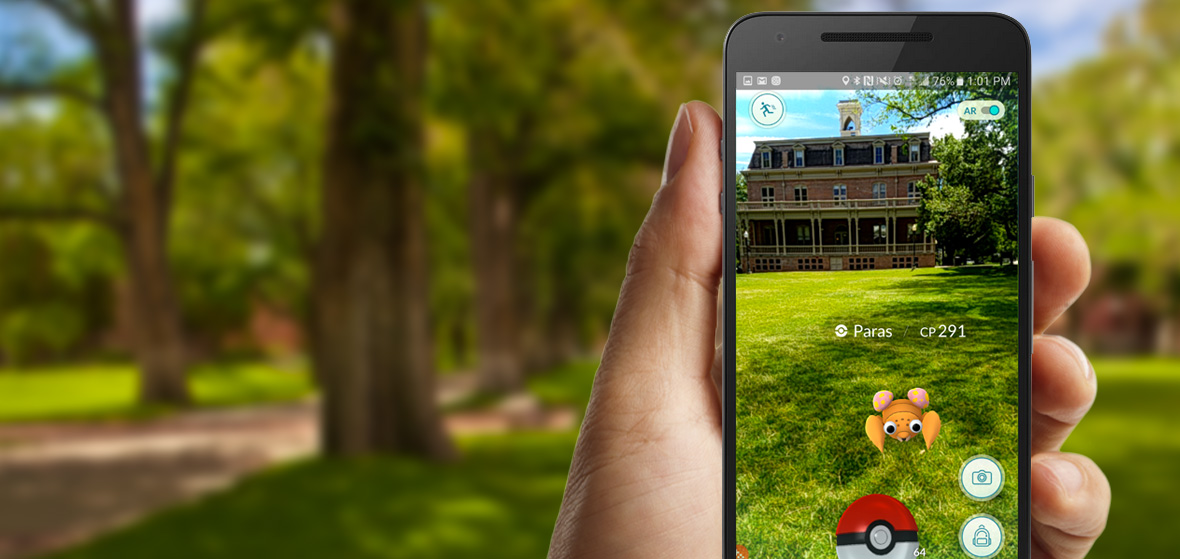Virtual monsters are spawning around the real world, and with 44 locations across campus to collect Pokéballs and other in-game items, called Pokéstops, the University of Nevada, Reno is a great place to meet with and make new friends while players of the game "catch 'em all!"
Pokémon GO, a game played on Android and iOS phones and devices, skyrocketed in popularity almost immediately following its July 6, 2016 U.S. release, with tens of millions of players reportedly downloading and using the app, and college campuses are no exception. The company that developed the game, Niantic, has not released any official numbers on downloads, but according to the New York Times and BBC, downloads are currently estimated between 20 and 30 million in the U.S. alone. With such an extreme and rapid rise in fame, one might expect the craze to be just a flash in the pan, but at San Diego's Comic-Con the CEO of the game, John Hanke, announced that the company has only published "probably a 10th" of their intended features, which is sure to keep people playing for some time to come.
How it works, why it's working and where it started
 Players log in to the game to see a small avatar standing on a map that represents them in the real world – similar to typical map apps like Google Maps. Using GPS, the game tracks the players as they move around and will randomly spawn virtual creatures called Pokémon that users can collect and use to battle with other players.
Players log in to the game to see a small avatar standing on a map that represents them in the real world – similar to typical map apps like Google Maps. Using GPS, the game tracks the players as they move around and will randomly spawn virtual creatures called Pokémon that users can collect and use to battle with other players.
Pokémon GO uses a technology called augmented reality or AR. Virtual parts of the game are superimposed over the real world as users view it real time through their phone. When a player goes to catch a Pokémon in-game, they have the option to use AR mode to view the animated cartoon creature standing somewhere in the world around them – such as a coworker's desk or other fun spots that players are taking screenshots of and sharing on social media - or to use a less dynamic view that doesn't require the phone's camera or accelerometers.
The game's success lies in a fairly simple premise – a player's desire to collect more powerful and rarer Pokémon – and an already massive and nostalgic fan base obsessed with all things Pokémon since the launch of the franchise in the mid-'90s. True devotees have been playing since the first Pokémon games hit Nintendo's Game Boy in 1998 (1996 in Japan). Almost immediately thereafter, the animated series hit televisions, the playing card version of the game hit stores and the popularity hit the moon. Since then, and after many iterations of the games and the shows, including feature-length movies, Pokémon has steadily built a larger audience, gaining new fans while retaining its place in the hearts of early adopters.
Above and beyond the incredible success of the game, what's remarkable about Pokémon GO is how it has turned what is typically a nonsocial crowd, "gamers," into people who are out and about, experiencing the world and each other.
"It gets people out and walking around from all different age groups and walks of life who might not normally associate with each other," engineering student Brett Knadle said.
Bringing Pokémon Masters together
While the "gyms" in the game may create some rivalry, much of the gameplay encourages socialization and teamwork. Players can buy a "lure" for a dollar and for 30 minutes a Pokéstop will generate pink blossoms illuminating the fact that the area will have a higher chance of spawning Pokémon. The lure effect works for everyone, and everyone has an opportunity to catch the same Pokémon, by drawing players to an area. Everyone has an opportunity to collect and more vocal groups of players are prone to call out locations of rarer Pokémon as well as cheer others on.
 The location-based game Niantic previously created, called Ingress, had its users index landmarks that were then incorporated into the game. Pokémon GO takes advantage of these user-generated landmarks, and players are finding themselves exploring local places of interest that they may never have experienced.
The location-based game Niantic previously created, called Ingress, had its users index landmarks that were then incorporated into the game. Pokémon GO takes advantage of these user-generated landmarks, and players are finding themselves exploring local places of interest that they may never have experienced.
"The game is great because it gives students and local community a greater awareness of University landmarks," mathematics student Ryan Battistone said. "It also encourages people to walk around more, so it could help the health of students around campus."
While it remains to be seen how popular the game will be on campus once fall semester begins, the number of people wandering around the University's many Pokéstops and gyms this summer is notable, especially when most players are holding their phones out with two hands. During lunch hours, afternoons and evenings, groups of people gather near the multiple stops found on the southeast corner of Manzanita Lake. The gyms on campus and around residence halls tend to create areas of congregation as well, especially the two near the Joe Crowley Student Union and the two near Max Fleischmann Agriculture. In and around the Quad are enough stops that one can stroll around continuously gathering Pokéballs. In short, the University is the place to be for up-and-coming Pokémon masters.
Pokémon GO locations on campus:
Pokémon locations on map:
Gyms
- Nye Hall
- Abstract Concrete Wall
- Joe Crowley Student Union
- Legacy Hall
- Fleischmann Planetarium and Science
- Center for Molecular Medicine
- Bibo's Train Mural
Pokéstops
- UNR South Fountain
- Manzanita Hall
- Manzanita Lake Fountain 1
- Clark Administration
- Distinguished Nevadans Memorial at UNR
- 1940 placard
- Morrill Hall Alumni Center
- The UNR Quad
- Peace Statue
- Wind Art UNR
- Bronze Building Dedication Plaque 1930
- F. Donald Tibbetts Memorial Plaza
- Frandsen Humanities
- Jones Center
- Thompson Building
- Reno LDS Institute of Religion
- Steel Through Concrete
- Steel Teaching Aid and Sculpture
- DeLaMare Science & Engineering
- Lincoln Hall
- Virginia Street Gym
- Church Fine Arts Complex
- Stained Glass Pillar
- Mack Social Sciences
- Schulich Lecture Hall
- Physics Building
- Sheppard Fine Arts Gallery
- Edmund J. Cain Hall
- Lounge Atrium Mural
- William J. Raggio Building
- Four Children Sculpture
- Randall Shiroma Sculpture
- Applied Research Facility
- Lawlor Events Center
- Nevada Shadow
- Margeurite Wattis Petersen Foundation Athletic Academic Center
- Nevada Historical Society
- School of Medicine
- Fleischmann Planetarium Sundial
- William and Pennington Health Sciences Building
- Reno Post Office
- Grand Army of the Republic Memorial Stop
- Evans Park Sign
- Donald W. Reynolds Stop
Please be safe, exercise caution and use common sense while using the app. If playing at night, play with friends whenever possible. Always pay attention to traffic while crossing the street. Try not to risk your well-being for a replaceable smartphone or to capture an artificial pocket monster – not even a super rare one.












